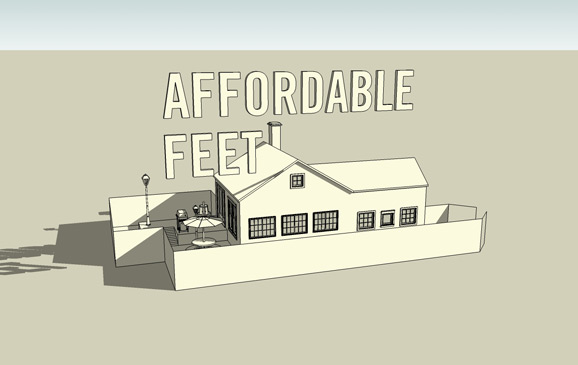
Guest writer Dan Maginn is a principal with el dorado inc, an architecture firm in Kansas City, Missouri. This four part series, “Square Feat,” will explore the myths and realities surrounding affordable housing.
I’m a relatively smart guy. I have read the opening pages of numerous Thomas Pynchon books, and have a working vocabulary of over 60 words—nearly half of them polysyllabic. As an architect and a citizen of these United States, “affordable” and “housing” are two words that occupy my word-bag, and I use them all the time (i.e. “These cheeseburgers are affordable. Let’s eat them and talk about housing.”). They are solid, workhorse words—but when they get clumped together (i.e. “Let’s eat these cheeseburgers and talk about affordable housing”) things start to go south rapidly.
The topic is a favorite in numerous design magazines. Stories on groovily designed “affordable” houses abound—complete with sexy images of attractive albeit not-quite-affordable-looking people living in the houses. Like thousands of others, I’m drawn to these images. I’m interested because—someday—I really want to abandon the grumpy box of walls that I occupy with my wife and live in a cool new house. And we don’t have a ton of money.
So why are my Champion Brand boxer briefs so tightly knotted about this issue as it has played out in the media the last couple of years? They are knotted because the discussion is often based on misinformation or inconsistent assumptions. Armed with my discerning, distrusting eye (developed after 20 bitter years of architectural practice) I can usually see through the marketing spin to the naked, quivering truth of architectural things. Typically, in the stories I read or lectures that I attend, there is some cleverly obfuscated tidbit that clouds the issue. Because so many of us are seeking the Holy Grail—a cool house that you can actually afford to buy—we want to believe, and we find ourselves conveniently blocking out the pesky facts that might disprove the claims of affordability. Only with serious sleuthing can one discover the truth: that this affordable modular house over here was built with donated material and student labor; that that affordable factory-fabricated house over there is way smaller than the photo seems to suggest; and that this shiny pink kit house, way over here, with all the reporters clustered around it, requires an expensive foundation that isn’t mentioned in the brochure (among other disappointments).
We want so bad to believe that we can have it all—a cool design with lots of space, for not a lot of money. But we can’t have it all.
Without a clear understanding of all of the variables involved (size, quality, erection method, operational expenses and the like), the discussion can potentially mislead those interested in the topic, imbuing their receptive and well-meaning brains with inaccurate non-facts. A meaningful discussion of affordable housing steers away from clever misdirections and obfuscated tidbits and hones in on the grinding but necessary variables, in all their uptight glory. Although such a discussion is perhaps not quite as miraculous-feeling as some of the (sort of) affordable housing stories in the mags, it is nevertheless far less disappointing and abandoned-in-the-parking-lot-at-the-prom-feeling in the end. link...


0 comments:
Post a Comment